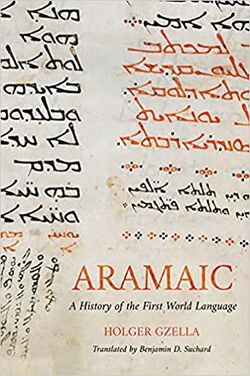Aramaic: A History of the First World Language (2021 Gzella), book
Holger Gzella, Aramaic: A History of the First World Language (Chicago, IL: Wm. B. Eerdmans Publishing Co., 2021).
Abstract
"A comprehensive history of the Aramaic language, from its first attestations around 1000 BCE to the modern day"--
Contents
1. Introduction -- The Importance of Aramaic -- A Brief History of Aramaic Studies -- Hallmarks of Aramaic Grammar -- The Evolution of Aramaic and Its Periodization -- Overview of This Book and a Guide to Further Study -- 2. The Oldest Aramaic and Its Cultural Context -- The Origin of Aramaic and the Linguistic Context of Syria-Palestine -- A New Writing Culture: The Alphabet's Big Break -- Speaking through Stone: The Context of the Old Aramaic Inscriptions; The Arameans and Their Southern Neighbors: Aramaic Writing Culture in Palestine -- Aramaic on the Move -- 3. Aramaic as a World Language -- Aramaic in Its Imperial Context -- Aramaic as the New Administrative Language of the Assyrian Empire -- Continuity in the Babylonian Period -- Codification and Maximal Extent in the Achaemenid Period -- The Imperial Aramaic Writing Tradition -- 4. Aramaic in the Bible and Early Judaism -- Aramaic's Integration in Palestine -- The Hebrew Bible and Aramaic -- Aramaic Books of the Bible and Their Background; The Aramaic Literary Tradition of Palestine and the Dead Sea Scrolls -- Aramaic as the Language of Jesus and the Background of the New Testament -- 5. Aramaic Between the Classical and Parthian Worlds -- A Network of Local Aramaic Written Languages -- Palmyra and the Palmyrenes between East and West -- In the Shadow of the Parthian Empire: Hatra, Eastern Mesopotamia, and Babylonia -- Dura Europos: Aramaic in a Greek Administrative Context -- The Arsacid Aramaic Writing Culture of the Parthians -- 6. Syriac and the End of Paganism -- Syriac Christianity and Its Cultural Context in Late Antiquity; Edessa, the Cradle of Syriac -- The Rise of Christian Syriac Literature in Edessa and Beyond -- Syriac as an International Ecclesiastical Language -- Syriac's Lasting Legacy -- 7. The Second Sacred Language: Aramaic in Rabbinic Judaism -- Hebrew and Aramaic in Jewish Textual Culture -- Jewish Palestinian Aramaic -- Jewish Babylonian Aramaic -- Aramaic Bible Translations between Palestine and Babylonia -- Between the Local and the Sacred: Judaism's Aramaic Legacy -- 8. Not Just Jews and Christians: Samaritans, Mandeans, and Others -- Aramaic and the Religions of Late Antiquity; Preaching to the Peasants: Christian Palestinian Aramaic -- Other Israelites: The Samaritans and Samaritan Aramaic -- Mythology and Mystery: The Mandeans in Babylonia -- In the Shadow of Orthodoxy: Aramaic Magic Texts and Folk Religion -- 9. Aramaic in Arabia and the Islamic World -- Aramaic and the Languages of the Arabian Peninsula -- The Nabateans and Aramaic as an Official Language in Arabia -- Aramaic and the Emancipation of Arabic as a Written Language -- The Spread of Arabic as the Language of Islam -- The Aramaic Legacy in Modern Arabic -- 10. Modern Aramaic from a Historical Perspective
